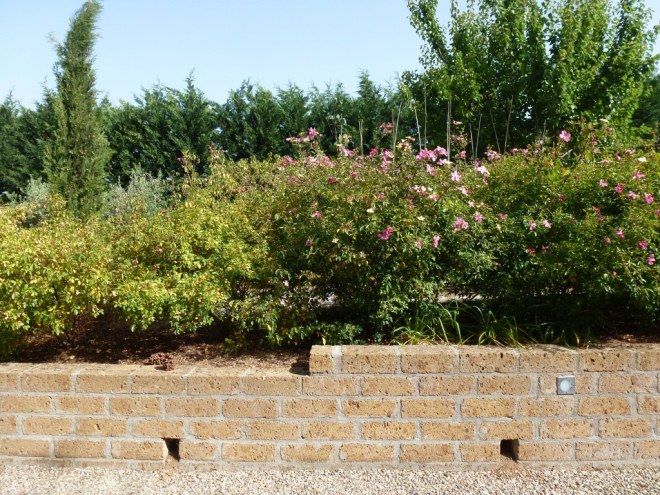Time again to join Helen the Patient Gardener for her end of month view.
May and June are usually the best months for me; the weather is warm enough to enjoy meals outside, the garden is full of flower and everything is lush and full. May was almost like this, but there were cool evenings which meant no meals outside. The beginning of June was very windy so again not many meals outside and the plants in the garden took quite a battering. In the middle of the month the temperatures soared AND there were hot winds!
I usually delay turning on the automatic irrigation (except to the vegetable garden) for as long as possible; 1, because I want the plants to become tough and search out water deep down and 2, as all the water comes from a well 100 m deep there is considerable cost in terms of electricity to pump the water to the surface.
As it was cool in May, especially at night, there was always dew on the ground each morning so I felt it correct to wait before beginning the irrigation this year. With hindsight this was a mistake; the desiccating effects of the wind were pulling water up out of the ground via the leaves. When I went to Prague I didn’t want to begin irrigating without being there to make sure there were no damaged pipes (there was one so I was right about that). The wind became even stronger and the temperature rose to 37° – 39° Celsius over those four days and when I returned the garden was scorched, I used the term “flame gun” and this wasn’t really an exaggeration. The irrigation is on now, I have been hand-watering to try to help some of the plants that were really suffering, but with temperatures now pretty much set for the next six to eight weeks the summer hibernation of the garden has started early! Some plants do continue to bloom with minimum irrigation and I’ll be showing those over the next weeks.
Some plants will reward me with abundant blooms with very little water. Rosa mutablibis is one that only needs minimum water to flower almost continuously. Gaura lindheimeri is another that with just a little irrigation or run off from nearby roses flower profusely. The groundcover Verbena near the terrace is flowering much more than usual because I’ve been watering pots on the terrace and water has run off from there to reach them.
Figs grow all around the Mediterranean and I’ve seen them growing out of cliffs with no soil, but mine needs water every year! In past years this hasn’t occurred until August, but just look at my poor tree, and this was even before the last week of June; the first crop of figs hasn’t been harvested yet although any day now some should be ready.
Rosa Rimosa again has had only run off water from watering pots on the terrace is giving a great second display.
 See more about this good tempered rose here.
See more about this good tempered rose here.
However the grasses are beginning to light up the garden, especially in the evening when the last rays of the sun shine through their flowers.
June is the month for Lavender and the sound of bees buzzing all day collecting nectar and of butterflies fluttering and dancing in the air above.
















































































